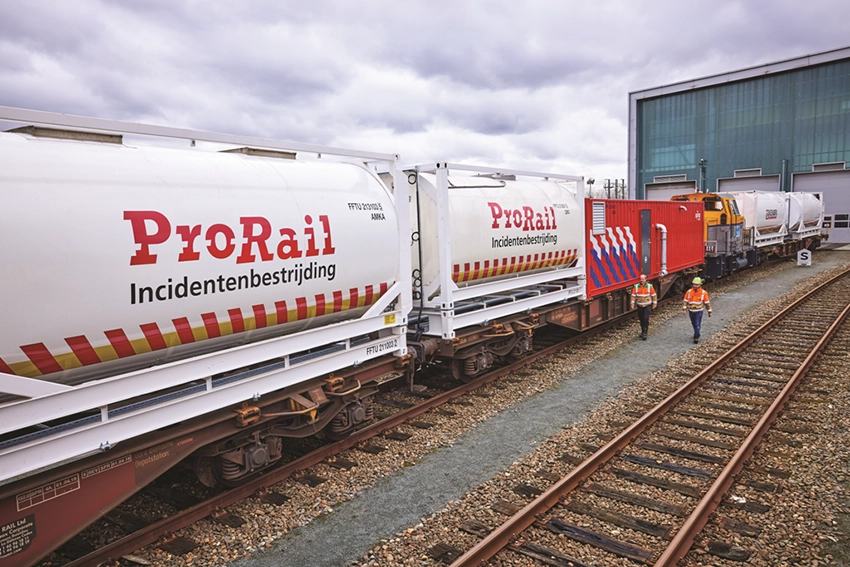Trends
Trends
JUN
11
2021
Transports & Logistics
When connectivity takes to the rails
Cellnex strengthens its presence in rail transport corridors.
Developing transport and telecommunications infrastructures to articulate territories, facilitate society, the economy and sustainability, is a top priority for world economies. “Build resilient infrastructure, promote sustainable industrialization and foster innovation” is the title of United Nations Sustainable Development Goal 9. The Next Generation EU European Recovery Plan recognises this priority, providing unprecedented support for the dual ecological and digital transition.
As it goes further into its digitalisation strategy, the European Commission is also trying to promote railways as a means of transport that is both sustainable (generating less than 0.5% of European CO2 emissions), efficient (connecting people, goods and companies across the EU), and reliable in terms of health and road safety.
Not surprisingly, 2021 has been declared the European Year of Rail to help achieve the objectives of the Green New Deal within the fourth railway package, a group of legislative measures to create an integrated railway area, removing the remaining institutional, legal and technical obstacles in the bloc and supporting economic growth.
As Europe’s largest wireless telecommunications infrastructure manager, Cellnex is located at the convergence of the transport and digitalisation universes. The transport sector represents one of the company’s main opportunities not only to achieve organic growth, but also for research and as a test bed for projects in clean, efficient, economical and sustainable territories thanks to the enormous possibilities offered by new low-latency technologies.
The deployment of telecommunications infrastructures in “special environments” such as underground (metro) or surface railway networks is ideal for a neutral operator like Cellnex, which can take charge of building, managing and operating the sites for transport concessionaires, mobile operators and other businesses.
In the United Kingdom, the national operator Network Rail recently awarded Cellnex a 25-year concessionary contract to provide uninterrupted cellular internet, mobile reception and fibre services along the length of the Brighton Mainline route. At the end of April, Dutch railway manager ProRail chose Cellnex to manage and expand its telecommunications infrastructures along railway lines and their areas of influence in the Netherlands.
Cellnex, which has just completed the roll-out of a common 4G network –through Metrocall– in the entire Madrid underground network (used by almost 700 million passengers a year) with a view to rolling out 5G, already has experience in underground infrastructures since it manages connectivity services for the Milan and Brescia undergrounds and the communications networks for security and emergencies in the Valencia and Barcelona metro.
Apart from the topography, tunnels or embankments that mark the more or less winding route of the carriages, Cellnex is betting on these contracts to guarantee the uninterrupted connectivity demanded by today’s society. Its projects in this area cover more than 600 kilometres of lines and 1.5 billion trips a year.
In addition to improving mobile coverage for users, these infrastructures will foster the growth of local communities along the route, promoting digital inclusion, driving efficiency in transport and energy and helping the transition to smart transport.
Smart solutions
The institutional boost to passengers and goods transport and the arrival of 5G significantly increase the number of possible applications of telecommunications infrastructures in these vital railway networks.
Just like in other basic services or security and emergency networks projects, deploying 5G networks in the rail sector will improve safety and energy efficiency, optimise services and “learn” from the experience with communication among objects facilitated by the Internet of Things (IoT) or immediate data analysis using Artificial Intelligence.
“Connectivity infrastructures will make it possible not only to improve network management or maintenance tasks. In combination with other elements of smart cities, they will make a decisive contribution to improving the management of the cities or territories themselves, offering a holistic vision of the city and its citizens using data analysis and management”, underlines Oscar Pallarols, Global Commercial Director of Cellnex.
It is against this backdrop that Cellnex takes part in the ambitious pan-European 5GMED project to deploy 5G technology in the Mediterranean Corridor between France and Spain. This cross-border project, which is 75 percent financed by the European Commission, plans to invest €16 million in pilot road and rail experiences between Figueres and Perpignan and will make it possible to test services ranging from automated remote driving, advanced traffic management to entertainment solutions with augmented reality for autonomous vehicles and railways.

















